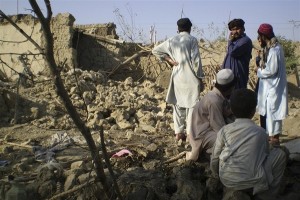Sunday Times 2
US has killed far more civilians with drones than it admits, says UN
A new report from a special UN investigator says drone strikes have killed far more civilians than US officials have publicly acknowledged – at least 400 in Pakistan and as many as 58 in Yemen – and chides the U.S. for failing to aid the investigation by disclosing its own figures.
UN Special Rapporteur Ben Emmerson, who issued the “interim” report, said the US had created “an almost insurmountable obstacle to transparency.”
“The Special Rapporteur does not accept that considerations of national security justify withholding statistical and basic methodological data of this kind,” wrote Emmerson in the report, which is due to be presented to the UN General Assembly next

Tribesmen gather at a site of a missile attack on the outskirts of Miranshah, near the Afghan border. Reuters file pic
Friday.
US intelligence officials have consistently downplayed the number of civilian deaths from drone strikes. In a June 2011 speech, White House counter-terrorism advisor John Brennan, who is now CIA director, said that “for nearly the past year, there hasn’t been a single collateral death because of the exceptional proficiency [and] precision” of US counter-terror strikes.
Later, the CIA acknowledged some civilian casualties, but told Congress that they were in the “single digits,” according to a February 2013 statement by Senate Intelligence Committee chair Sen. Diane Feinstein, D.-Calif.
In a major speech on drone strikes this May, President Obama openly acknowledged civilian deaths, saying “they will haunt us for as long as we live” — but didn’t provide any hard numbers or estimates.
“It is a hard fact that US strikes have resulted in civilian casualties, a risk that exist in every war,” Obama said. “And for the families of those civilians, no words or legal construct can justify their loss.”
According to Emmerson, the Pakistani government provided him with new casualty numbers for strikes in the country’s Federally Administered Tribal Areas (FATA), where the US government has targeted al Qaeda operatives and their associates since 2004. While acknowledging the difficulty in compiling precise figures in a region largely beyond government control, he states that Pakistani officials confirmed “at least 400 civilians had been killed as a result of remotely piloted aircraft strikes and a further 200 individuals [killed] were regarded as probably non-combatants.” He added that Pakistani officials said those figures were likely to be an underestimate, due to “underreporting and obstacles to effective investigation.”
Emmerson told NBC News that there is no reason “on the face of it” to question the Pakistani government’s number because they were broadly in line with the lower end of figures compiled by non-governmental groups and independent media monitoring. He said one major difficulty in calculating any numbers is a differing view of who constitutes a civilian. Pakistani officials, he said, tend to view the owner of a home where suspected al Qaeda operatives are staying as a non-combatant, an assessment not generally shared by US officials.
Emmerson also said that he and his researchers had identified 33 “sample remotely piloted aircraft strikes that appear to have resulted in civilian casualties.” Most of these were by the U.S., he said, but about “eight or nine” were Israeli strikes in Gaza. He did not identify the strikes, saying he is still investigating them and plans to present his findings to the U.N. Human Rights Council.
comments powered by Disqus
